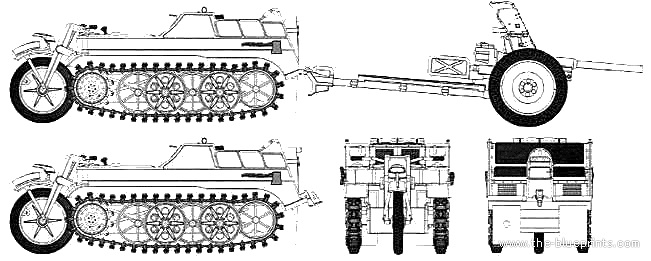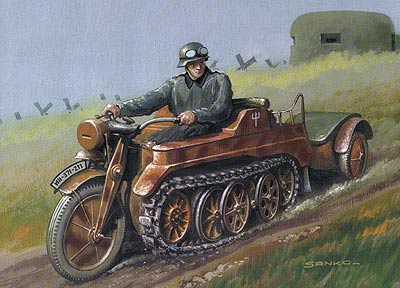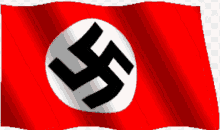| Sd. Kfz. 2) "Kettenkrad." |
|---|
 |
|---|
| Sd.Kfz. 2 Diagram. |
|---|
| Type: | Light half-track gun tractor. |
|---|
| Place Of Origin: | German. |
|---|
| Service History: |
|---|
| In Service: | 1941-1945. |
|---|
| Used By: | Nazi Germany. |
|---|
| Wars: | World War II. |
|---|
| Production History: |
|---|
| Designer: | NSU. |
|---|
| Designed: | 1939. |
|---|
| Manufacturer: | NSU Motorenwerke. |
|---|
| Produced: | 1939-1948. |
|---|
| Specifications: |
|---|
| Weight: | 1,560 kg (3,440 lb). |
|---|
| Length: | 3 m (9 ft 10 in). |
|---|
| Width: | 1 m (3 ft 3 in). |
|---|
| Height: | 1.2 m (3 ft 11 in). |
|---|
| Crew: | 1 (driver). |
|---|
| Passengers: | Seating for 2 safely; As many at 8 were recorded in one incident (during a retreat). |
|---|
| Engine: | Opel water cooled four-cylinder inline engine, 36 bhp (26 kW). |
|---|
| Transmission: | 3 forward/1 reverse times 2 range. |
|---|
| Speed: | 70 km/h (44 mph). |
|---|
 |
|---|
| A Kettenkrad In The Field. |
|---|
The SdKfz 2, better known as the Kleines Kettenkraftrad HK 101 or Kettenkrad for short (Ketten=chain/tracks, krad=military abbreviation of the German word Kraftrad, the administrative German term for motorcycle), started its life as an artillery tractor for airborne troops. The vehicle was specifically designed to fit inside the hold of a Junkers Ju 52 aircraft for delivery purposes (though not by parachute) and was the lightest mass-produced German military vehicle to use the Schachtellaufwerk overlapped and interleaved road wheels used on almost all German military half-track vehicles of World War II.Steering the Kettenkrad was accomplished by turning the handlebars: Up to a certain point, only the front wheel would steer the vehicle. A motion of the handlebars beyond that point would engage the track brakes to help make turns sharper. It was also possible to run the vehicle without the front wheel installed and this was recommended in extreme off-road conditions where speed would be kept low.The SdKfz 2 was designed and built by the NSU Werke AG at Neckarsulm, Germany. First designed and patented in June 1939, it was First used in the invasion of the Soviet Union in 1941. Later in the War Stoewer from Stettin also produced Kettenkrads under license, accounting for about 10% of the total production.Most Kettenkrads saw service on the Eastern Front, where they were used to lay communication cables, pull heavy loads and carry soldiers through the deep Russian mud. Later in the War, Kettenkrads were used as runway tugs for aircraft, especially for both the Me 262 jet fighter, and sometimes the Arado Ar 234 jet reconnaissance-bomber. In order to save aviation fuel, a German jet aircraft would be towed to the runway, rather than taxiing under their own power.The vehicle was also used in the North African theater and on the Western Front.The Kettenkrad came with the Sd.Anh. 1 (sonderanhanger: "special trailer") which could be attached to it to improve its cargo capacity.Being a tracked vehicle, the Kettenkrad could climb up to 24 degrees in sand and even more on hard ground.Only two significant sub-variations of the Kettenkrad were constructed. Production of the vehicle was stopped in 1944, at which time 8,345 had been built. After the War, production resumed at NSU. Around 550 Kettenkräder were built for agricultural use, with production ending in 1948 (some sources say 1949).RedevelopmentFor reasons which have never been completely clear, TDA representatives requested the Kettenkrad as part of the Historic Tanks program, but with gravpods pre-installed and available for use. 15 were produced in the initial run; A further 2 per final program vehicle ("self excluded") were requested, with the last one being delivered just days after the last tank.During the development process, no surviving blueprints nor running examples could be found, though several hundred non-functional units were available, some for examination- Several not so much. One developer risked possible jail time and significant fines by trespassing on a farmer's land to examine the unit in her tractor lot after being denied access; Though he did not touch nor damage the unit, the farmer, once she became aware of the intrusion, became irate and actually DID call the local law enforcement to have him arrested (by this time, he was long gone), and later sued (the case was settled out of court for a large, but never disclosed, sum).Practical ApplicationThe Ketterkrad's practical application, especial vis-a-vis the Historic Tanks program, was highly limited; Their capabilities to tow damaged tanks was fairly non-existent, to deliver parts for damaged tanks questionable for practical application (at last in combat), and suitability as a crew rescue vehicles fairly limited. In numbers, using gravpods, they 'could' tow a disabled tank off the lines, but the field testing showed quite clearly they couldn't effect the battle space in any practicable and efficient fashion. Their original purpose, towing artillery, was antiquated, a relic of a form of Warfare generally out of existence; The few forms of artillery that still did use unpowered mounts (the L-02a Rail Launcher and L-08 Rail Launcher) are designed for the TU-01 Basic Trailer Unit, which the Kettenkrad can not tow over water, a primary reason for the TU-01 BTU's existence.Current StatusThe units already delivered will be kept in service, and replacement parts acquired as needed, but no further units are to be ordered without prior authorization of the TDA; The scandal that developed with the Kettenkrad's procurement (an unnecessary and questionably useful machine in some numbers, albeit at a relatively limited cost) could have become a significant problem (it fortunately broke in the news at the same time as a sex scandal in President's Point, and therefore ended up buried in other stories) for the program. In the end, it did lead to a significant scaling back, with many of the units for other vehicles indefinitely suspended (most especially the Hanomag). |



